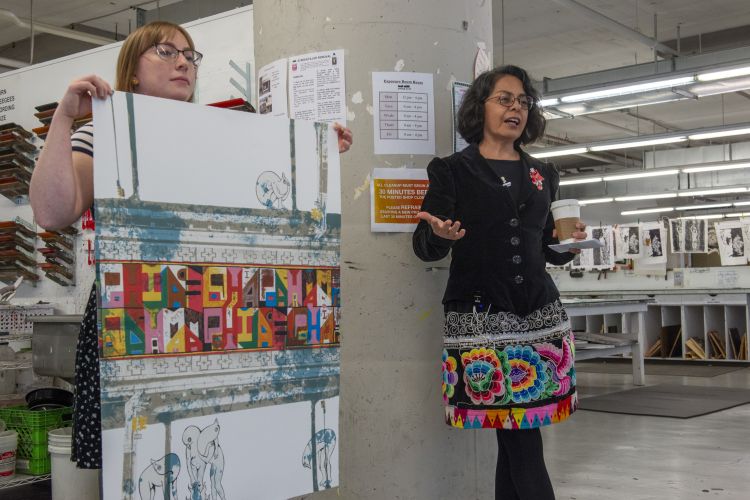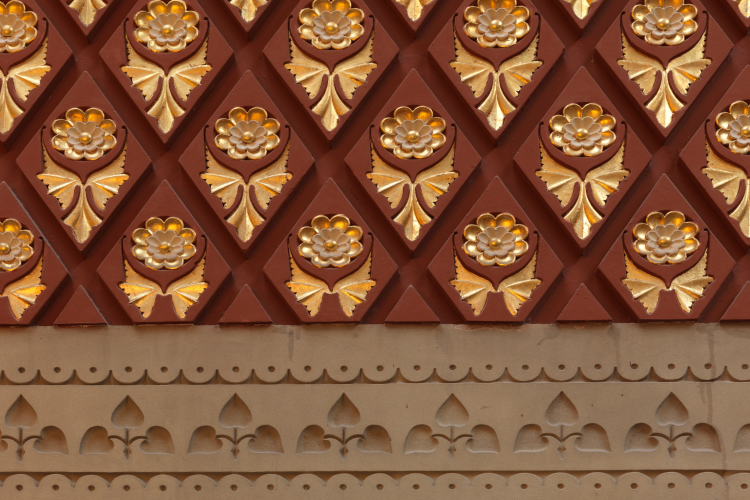STORIES FROM PAFA
Abigail Gray Swartz
Abigail Gray Swartz: Illustrating the Women’s Movement
When Abigail Gray Swartz’s illustration of a reimagined Rosie the Riveter graced the cover of The New Yorker in 2017, friends and family kept saying she had won the artist lottery.
In the weeks after the cover’s release she sold more work in two weeks than she had in all of 2016. But this moment in the spotlight wasn’t a fluke; it was recognition of the work Swartz has been putting in for years.
After getting a BA in Fine Art at Principia College and spending a year living in Alaska, Swartz enrolled in the certificate program at PAFA and eventually applied to the MFA program.
"In the grad program I sort of dove into installation art. Both of my grandparents passed away close together at that time and I needed to process such a big loss," she said from her home in Maine. "I wanted to put oil painting on hold and I dove into installation work, and I made rooms out of old wallpaper with sound and light. I continued my liberal arts education through grad school with the smorgasbord of everything PAFA offered."
Although she came from a family of artists and writers, Swartz said her parents were reluctant that studying art could be a viable path. But she points to the trajectory of her career and how technology has made it easier for artists to make their own way.
"I’ve had to tell my parents that technology is revolutionizing how artists can make it," she said. "You can get discovered on Instagram and have a following there and have a retail site."
Swartz began selling garlands on Etsy, eventually realizing she wanted to be an illustrator. A neighbor of hers in Pennsylvania wrote for Motherlode, the New York Times blog now known as Well Family and needed art for her columns. Swartz was hired for a 3-month artist-in-residence position to create art for the blog, and continued working for the Times for six months after the initial residency ended. Swartz said working with The New York Times allowed her to polish her illustration skills and make deeper connections in the publishing world
The Times led to work for Lenny Letter and various magazines, but she always had her eye on her illustrations appearing in The New Yorker.
"The New Yorker was on my bucket list and I wrote a three to five year plan. So I started to follow Francoise Mouly, the art director for New Yorker covers, to get a feel for what I needed to do," Swartz said.
Eventually Swartz’s work, a portrait of Rosa Parks, appeared in Mouly’s Resist. She then pitched the Rosie image that would take her career to another level. After a flurry of emails back and forth, Swartz’s drafts were being mocked up with New Yorker headlines.
"It was a snow day and my kids were home sick and I was having my own internal female empowerment moment of telling myself I would get it done," she said.
"I wasn’t allowed to tell anyone until The New Yorker announced it and I described it like exam week while giving birth while getting married. It was a real rollercoaster of emotions of the pressure of not sleeping, but the jubilation of emotions for something that was life changing, like the milestones of giving birth or getting married."
Her New Yorker cover has since been turned into a puzzle, greeting cards, a tee shirt, and a beach towel. Through Swartz’s own site she is selling prints, greeting cards, and calendars featuring her "Rosie" illustration and other prominent women.
"I feel like all artists careers have a different path and arc, and this is what I realized with illustration," she said. "I wanted to be creative for a living and what sells better, illustrations or installations? So there was that bit of just realizing what stuff is marketable. But more importantly what art could I make while the kids napped? Becoming a mom reawakened my childhood dream of illustrating books. I want to leave behind a series of books for my great great grandchildren."
Not that all of her time is spent on work that is more commercially successful. In 2018, Swartz has plans for a mural featuring local female artists in Maine, and she’ll be moving into a larger studio space to work on her oil painting.
"By diversifying, if something goes quiet then I have these other pots on the stove supporting me," she said. "People always need portraits for things. Lenny Letter and Taproot Magazine recently asked me for portraits. In some ways it’s career security and the portraits allow me to work on other creative avenues."
She also recently signed with an agent and hopes to begin illustrating books.
"It’s been a wonderful year, the New Yorker cover was such a career boost and it was thrilling to be a part of the Women’s March in that way. It’s been wild to have people come up to me at an event and tell me what things I’ve made mean to them. But like with any career milestone, there are continued highs and lows and a new set of goals."






